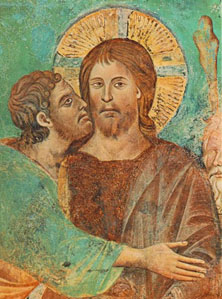Wednesday is the only day of Easter week that is not reported on by the gospel writers. But there are a few other things I’d like to point out today. First of all, in all the four Gospels (Matthew, Mark, Luke and John), one-sixth of the text is used to describe the twenty-four hours beginning with the last supper and ending with the burial of Jesus. This means that if every day in the life of Jesus were this complete we would have 180 volumes as large as our whole Bible (Vincent 1:433). Oh, how Matthew, Mark, Luke and John wanted us to understand the significance of the Atonement of Jesus Christ.
There are also many things I left out that happened on Tuesday. One I can’t neglect and that is the story of the Widow’s mite. We are told that Jesus was in the treasury which was a hall in the temple where gifts were deposited in thirteen receptacles shaped like trumpets. Jesus watched as one by one rich men paraded through the hall and cast their gifts into the trumpets, but then a poor widow cast in two meager mites. Not wanting this to go unnoticed by his disciples, Jesus made a point of it. “Of a truth,” He told them, “This poor widow has cast in more than all of the others. For they gave a little from their abundance, but she has given all she has.”
In contrast to this story we find another account concerning money. It was also on Tuesday that Judas set into motion the plot to kill Jesus. There is much irony in the very name Judas, for it means “he shall be praised.” We are told that Judas had become offended because of the Savior’s words (JST Mark 14:10) and so he went to the chief priests and asked, “What will ye give me if I deliver Jesus unto you?” And they agreed on a price of 30 pieces of silver.
Scholars and others have purported many estimates of what those 30 pieces of silver are worth in today’s money. I’ve found reports of anywhere between $7.20 to $40,000. This tells us that no one really knows for sure, but the fact that the chief priests later use the money to buy a plot of ground to be used as a cemetery tells us that it was a substantial amount of money. What is more important is that the 30 pieces of silver is fulfillment of a prophecy made in Zechariah 11:12 in which we are told, “So they weighed for my price thirty pieces of silver,” which in those days was the price that under the law of Moses a man must pay to a neighbor if the man’s animal caused the death of the neighbor’s slave. In other words, 30 pieces of silver was considered the monetary worth to replace a slave.
The symbolism of this slave metaphor is profound and in many Bible stories this symbolism foreshadows the “selling” of Jesus. For example, it was Judah, one of the twelve sons of Jacob, who proposed and sold his brother Joseph as a slave, and now it is Judas who proposes and sells his brother Jesus for the price of a slave.
After the crucifixion, Judas regrets what he has done and returns the money to the chief priests saying, “I have sinned in that I have betrayed the innocent blood” (Matthew 27:4). But the chief priests refuse (you can almost hear them laughing in derision) to accept the money for the temple treasury because it is “blood money” and would profane and desecrate the temple. The irony here is mind boggling. They are too pious to accept “tainted ” money, but have no qualms about murdering Jesus.
When they refuse the money, Judas throws down the silver, leaves the temple, and hangs himself. So the chief priests are left with the money and since they won’t put blood money in the treasury, they buy the potter’s field. Of this part of the story Zechariah prophesies, “Cast it unto the potter: a goodly price that I was prised at of them” (Zechariah 11:13).
Pondering these stories leads all of us to the question,
“What is Jesus worth to us?”
Discovering the answer to that question is what Easter week is all about.










1 comment:
I love that story and picture of the Widow's mite. :)
Post a Comment